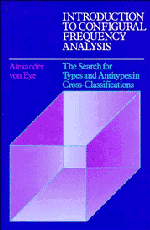 Introduction to Configural Frequency Analysis
Introduction to Configural Frequency Analysis Book contents
- Frontmatter
- Contents
- Preface
- Part I Concepts of configural frequency analysis
- Part II Applications and strategies of CFA
- Part III Methods of longitudinal CFA
- 6 CFA of change over time
- Part IV Strategies of CFA and computational issues
- Appendix A Computational issues. The estimation of tail probabilities for the standard normal and the F distributions
- Appendix B Estimation of expected frequencies in 2 × 2 × 2 tables under the assumption that main effects and first order interactions exist
- Appendix C Critical alpha levels under Holm adjustment for up to 330 cells and a priori alphas 0.05 and 0.01
- References
- Subject index
- Author index
6 - CFA of change over time
from Part III - Methods of longitudinal CFA
Published online by Cambridge University Press: 04 August 2010
- Frontmatter
- Contents
- Preface
- Part I Concepts of configural frequency analysis
- Part II Applications and strategies of CFA
- Part III Methods of longitudinal CFA
- 6 CFA of change over time
- Part IV Strategies of CFA and computational issues
- Appendix A Computational issues. The estimation of tail probabilities for the standard normal and the F distributions
- Appendix B Estimation of expected frequencies in 2 × 2 × 2 tables under the assumption that main effects and first order interactions exist
- Appendix C Critical alpha levels under Holm adjustment for up to 330 cells and a priori alphas 0.05 and 0.01
- References
- Subject index
- Author index
Summary
In longitudinal research one or more samples of n subjects are observed t times on d variables. Each variable may either be constant or change across time. Parameters that systematically vary display a trend (cf. Anderson 1971; Metzler and Nickel 1986). For instance, time series have a trend in location if the mean of the observed variable systematically varies over the t observation points. Examples of trends in location include monotone linear trends, that is, constant increases or decreases in the mean. Other time series may have a quadratic trend, that is, they look either U-shaped or inversely U-shaped. Still other time series may have a trend in dispersion. For instance, it has been hypothesized that the dispersion of intelligence increases during childhood and adolescence and decreases during senescence.
If we analyze ordinal or continuous variables, we are interested chiefly in trends in location. If we analyze nominal variables, on the other hand, we are interested in shifts from one configuration to another. Trends in location at the ordinal level can be identified by cases that, t later points in time, show higher or lower scores than those observed at earlier points in time. For example, suppose a psychotherapist uses a seven point scale to measure patient anxiety, with higher scores indicating more anxiety. An example of a trend would be a monotonous decrease in scores on the scale, across time.
- Type
- Chapter
- Information
- Introduction to Configural Frequency AnalysisThe Search for Types and Antitypes in Cross-Classification, pp. 145 - 204Publisher: Cambridge University PressPrint publication year: 1990
